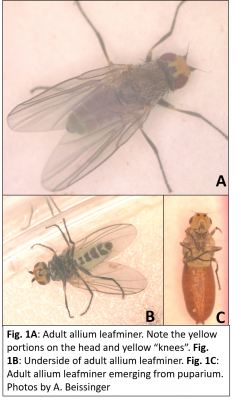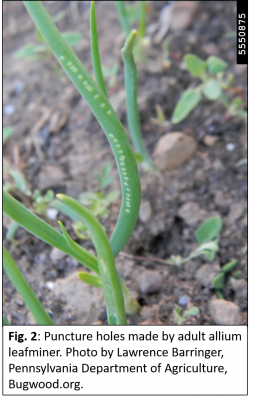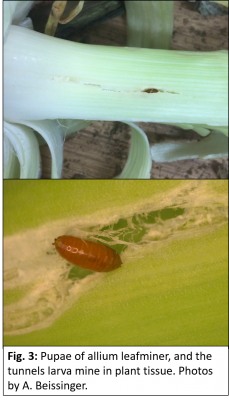The allium leaf miner (Phytomyza gymnostoma) was first reported in the northeast in 2015, but was not found in Connecticut until January 2020. Learn more about this pest and how to prepare for it this season.
The allium leafminer is an Agromizyid, or leafmining fly, native to Poland and Germany. While leek and onion may be the most heavily damaged crops, many crops in the Allium genus are susceptible, including shallot, chives, garlic, and green onion. Some species of wild onion and ornamental alliums may be hosts as well, but the full host range is currently unknown.
Adults (Fig 1a-c) lay eggs in the top of leek leaves between late March and May, by making repeated punctures with their ovipositor in the distal end of leaves (Fig. 2). These holes are the first signs of an infestation. The larva mine the leaves, creating tunnels of damage as they eat tissue (Fig 3). Larva will move down to bulb and leaf sheaths, where they pupate either in the plant or drop into the soil. The tunnels the larva create and leaf puncture holes provide good entry point for secondary fungal and bacterial infections, which can cause further damage to the crop. The second generation will emerge in September to October, laying eggs in the leaves again, and the pupa will overwinter.
Avoidance of the adult flies is one of the best prevention strategies. Covering all alliums prior to the emergence of adults (late March-May), may help exclude the pest. Alternatively, delaying planting until after the adults have emerged and their oviposition period is over, around mid-May, may be an effective strategy. If an infestation occurs, rotate out of leeks and other alliums in that area. Utilize yellow sticky cards and/or yellow bowls containing soapy water in infested fields. Contact PlantDiagnosticLab@UConn.edu to send a sample for identification.
There are insecticides that may be effective for allium leaf miner control, including both organic and conventional options. Always check the pesticide label to confirm the crop is listed, the rates, and the days to harvest intervals. This information can be found in the references section below.



References
- Fleischer, S. and Elkner, T. 2016. Pest alert: Allium leaf miner. Penn State University Extension. https://ento.psu.edu/extension/vegetables/pest-alert-allium-leafminer
- Gilrein, D. 2016. Insecticides for leafminers in onions and related crops that may be effective against allium leafminer (Phytomyza gymnostoma). Cornell Cooperative Extension of Suffolk County. https://www.agriculture.pa.gov/Plants_Land_Water/PlantIndustry/Documents/Insecticides%20for%20leafminers%20in%20onions%20and%20related%20crops.pdf
- Hutchinson, M. Allium leaf miner. Pennsylvania Department of Agriculture. https://www.agriculture.pa.gov/Plants_Land_Water/PlantIndustry/Entomology/Pages/ALLIUM-LEAFMINER.aspx
Author’s Note
This article appeared in the April 2020 edition of Crop Talk, UConn Extension and Plant Science & Landscape Architecture's Quarterly Newsletter for commercial fruit and vegetable growers. You can find the rest of the publication here: http://ipm.uconn.edu/documents/view.php?id=1663. To sign up to receive the digital newsletter, contact: mackenzie.white@uconn.edu.